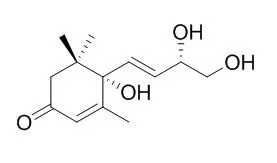| In vitro: |
| Pharm Biol. 2015 Nov;53(11):1602-7. | | Chemical constituents of the Annona glabra fruit and their cytotoxic activity.[Pubmed: 25856711] |
METHODS AND RESULTS:
One new, (2E,4E,1'R,3'S,5'R,6'S)-dihydrophaseic acid 1,3'-di-O-β-d-glucopyranoside, and eight known compounds, (2E,4E,1'R,3'S,5'R,6'S)-dihydrophaseic acid 3'-O-β-d-glucopyranoside (2), icariside D2 (3), icariside D2 6'-O-β-d-xylopyranoside (4), 3,4-dimethoxyphenyl O-β-d-glucopyranoside (5), 3,4-dihydroxybenzoic acid (6), blumenol A (7), Cucumegastigmane I (8), and icariside B1 (9), were isolated from the fruits of A. glabra.
CONCLUSIONS:
Icariside D2 (3) was found to show significant cytotoxic activity on the HL-60 cell line with the IC50 value of 9.0 ± 1.0 µM and did not show cytotoxic activity on the Hel-299 normal cell line. | | Fitoterapia. 2013 Jan;84:227-36. | | Phytochemical and therapeutic potential of cucumber.[Pubmed: 23098877] | The fruit is refrigerant, haemostatic, tonic and useful in hyperdipsia, thermoplegia etc. The seeds also have a cooling effect on the body and they are used to prevent constipation.
METHODS AND RESULTS:
Several bioactive compounds have been isolated from cucumber including cucurbitacins, Cucumegastigmane I and Cucumegastigmane II, cucumerin A and B, vitexin, orientin, isoscoparin 2″-O-(6‴-(E)-p-coumaroyl) glucoside, apigenin 7-O-(6″-O-p-coumaroylglucoside) etc. Despite huge exploration of cucumber in agricultural field, comparatively very few studies have been published about its chemical profile and its therapeutic potential. This article reviews the therapeutic application, pharmacological and phytochemical profile of different parts of C. sativus.
CONCLUSIONS:
In this review we have explored the current phytochemical and pharmacological knowledge available with this well known plant and several promising aspects for research on cucumber. |
|






 Cell. 2018 Jan 11;172(1-2):249-261.e12. doi: 10.1016/j.cell.2017.12.019.IF=36.216(2019)
Cell. 2018 Jan 11;172(1-2):249-261.e12. doi: 10.1016/j.cell.2017.12.019.IF=36.216(2019) Cell Metab. 2020 Mar 3;31(3):534-548.e5. doi: 10.1016/j.cmet.2020.01.002.IF=22.415(2019)
Cell Metab. 2020 Mar 3;31(3):534-548.e5. doi: 10.1016/j.cmet.2020.01.002.IF=22.415(2019) Mol Cell. 2017 Nov 16;68(4):673-685.e6. doi: 10.1016/j.molcel.2017.10.022.IF=14.548(2019)
Mol Cell. 2017 Nov 16;68(4):673-685.e6. doi: 10.1016/j.molcel.2017.10.022.IF=14.548(2019)